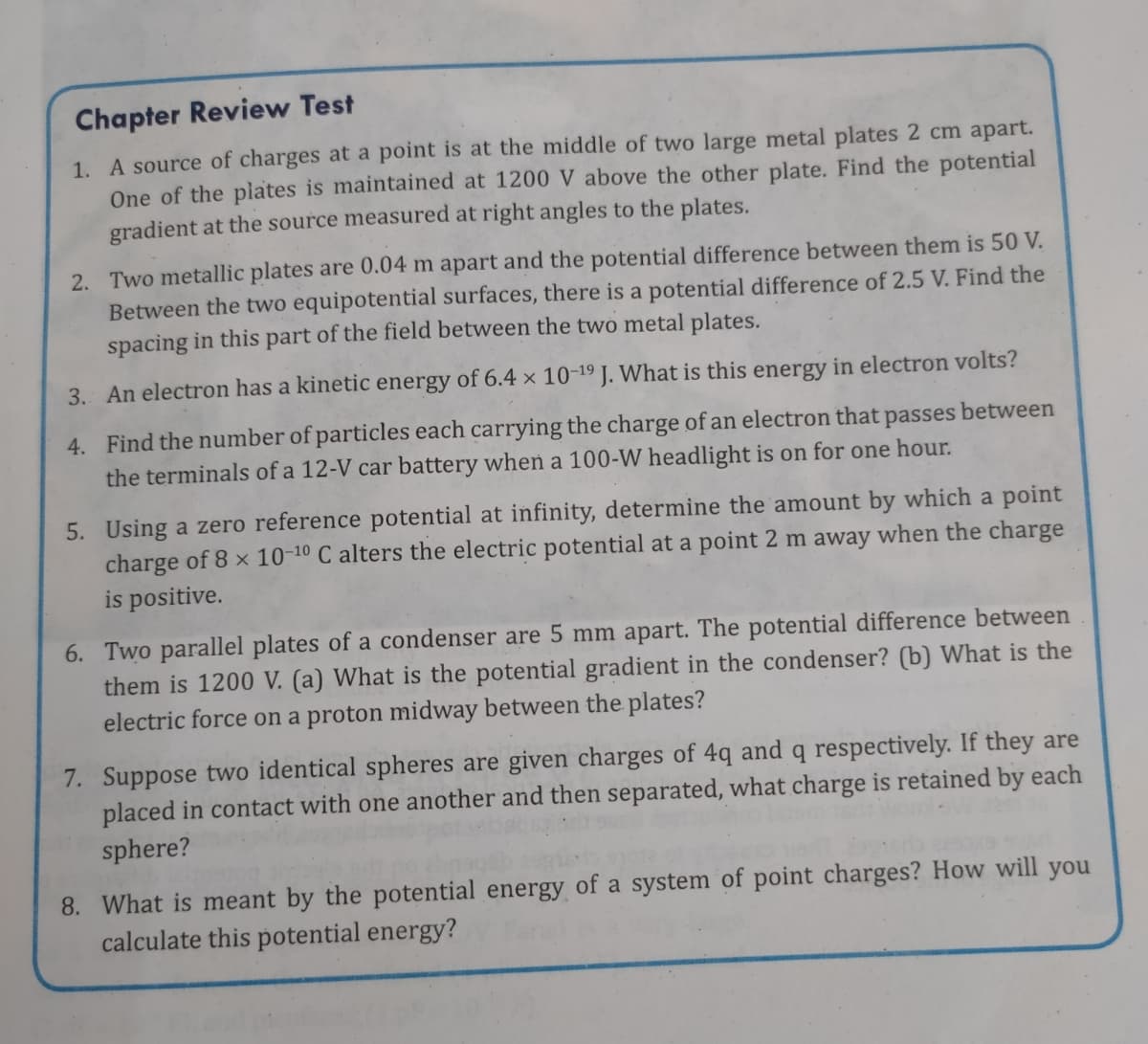gradient at the source measured at FIg 2. Two metallic plates are 0.04 m apart and the potential difference between them is 50 V. Between the two equipotential surfaces, there is a potential difference of 2.5 V. Find the spacing in this part of the field between the two metal plates. On electron has a kinetic energy of 6.4 x 10-19 J. What is this energy in electron volts?
gradient at the source measured at FIg 2. Two metallic plates are 0.04 m apart and the potential difference between them is 50 V. Between the two equipotential surfaces, there is a potential difference of 2.5 V. Find the spacing in this part of the field between the two metal plates. On electron has a kinetic energy of 6.4 x 10-19 J. What is this energy in electron volts?
Physics for Scientists and Engineers: Foundations and Connections
1st Edition
ISBN:9781133939146
Author:Katz, Debora M.
Publisher:Katz, Debora M.
Chapter26: Electric Potential
Section: Chapter Questions
Problem 75PQ: A long thin wire is used in laser printers to charge the photoreceptor before exposure to light....
Related questions
Question
Don't include no. 1

Transcribed Image Text:Chapter Review Test
1. A source of charges at a point is at the middle of two large metal plates 2 cm apart.
One of the plates is maintained at 1200 V above the other plate. Find the potential
gradient at the source measured at right angles to the plates.
2. Two metallic plates are 0.04 m apart and the potential difference between them is 50 V.
Between the two equipotential surfaces, there is a potential difference of 2.5 V. Find the
spacing in this part of the field between the two metal plates.
3. An electron has a kinetic energy of 6.4 × 10-19 J. What is this energy in electron volts?
4. Find the number of particles each carrying the charge of an electron that passes between
the terminals of a 12-V car battery when a 100-W headlight is on for one hour.
5. Using a zero reference potential at infinity, determine the amount by which a point
charge of 8 x 10-10 C alters the electric potential at a point 2 m away when the charge
is positive.
6. Two parallel plates of a condenser are 5 mm apart. The potential difference between
them is 1200 V. (a) What is the potential gradient in the condenser? (b) What is the
electric force on a proton midway between the plates?
7. Suppose two identical spheres are given charges of 4q and q respectively. If they are
placed in contact with one another and then separated, what charge is retained by each
sphere?
8. What is meant by the potential energy of a system of point charges? How will you
calculate this potential energy?
Expert Solution
This question has been solved!
Explore an expertly crafted, step-by-step solution for a thorough understanding of key concepts.
Step by step
Solved in 3 steps

Knowledge Booster
Learn more about
Need a deep-dive on the concept behind this application? Look no further. Learn more about this topic, physics and related others by exploring similar questions and additional content below.Recommended textbooks for you

Physics for Scientists and Engineers: Foundations…
Physics
ISBN:
9781133939146
Author:
Katz, Debora M.
Publisher:
Cengage Learning


Physics for Scientists and Engineers
Physics
ISBN:
9781337553278
Author:
Raymond A. Serway, John W. Jewett
Publisher:
Cengage Learning

Physics for Scientists and Engineers: Foundations…
Physics
ISBN:
9781133939146
Author:
Katz, Debora M.
Publisher:
Cengage Learning


Physics for Scientists and Engineers
Physics
ISBN:
9781337553278
Author:
Raymond A. Serway, John W. Jewett
Publisher:
Cengage Learning

Physics for Scientists and Engineers with Modern …
Physics
ISBN:
9781337553292
Author:
Raymond A. Serway, John W. Jewett
Publisher:
Cengage Learning

Physics for Scientists and Engineers, Technology …
Physics
ISBN:
9781305116399
Author:
Raymond A. Serway, John W. Jewett
Publisher:
Cengage Learning

Principles of Physics: A Calculus-Based Text
Physics
ISBN:
9781133104261
Author:
Raymond A. Serway, John W. Jewett
Publisher:
Cengage Learning